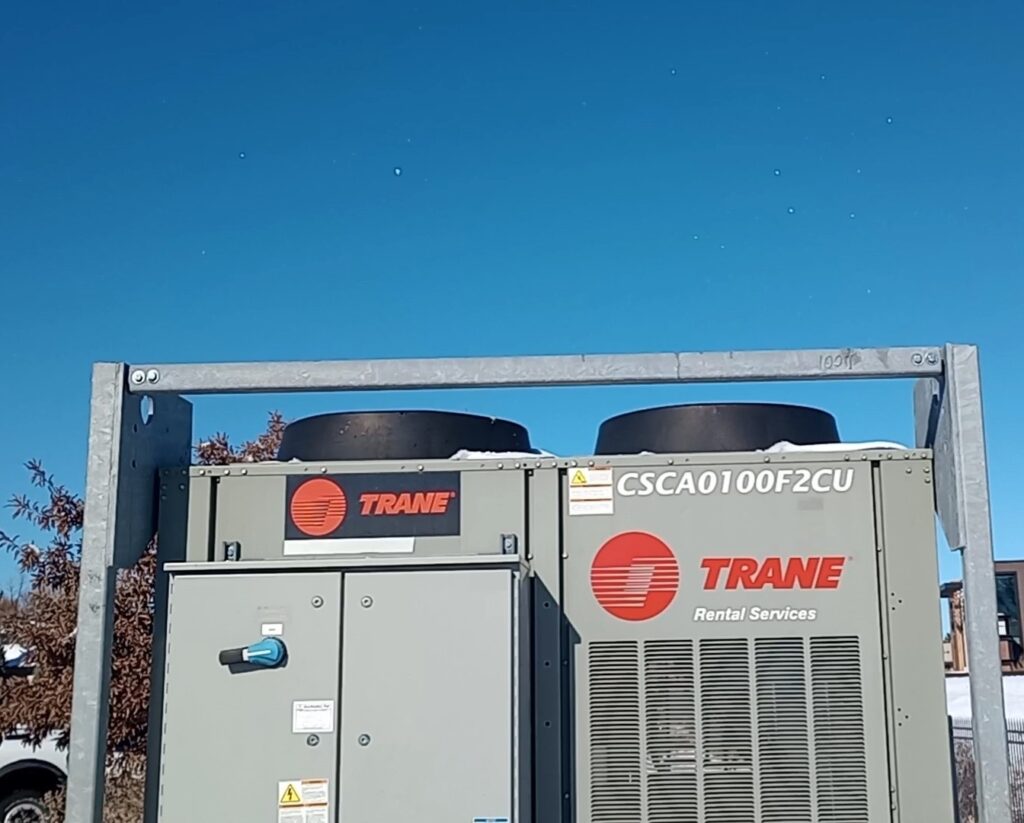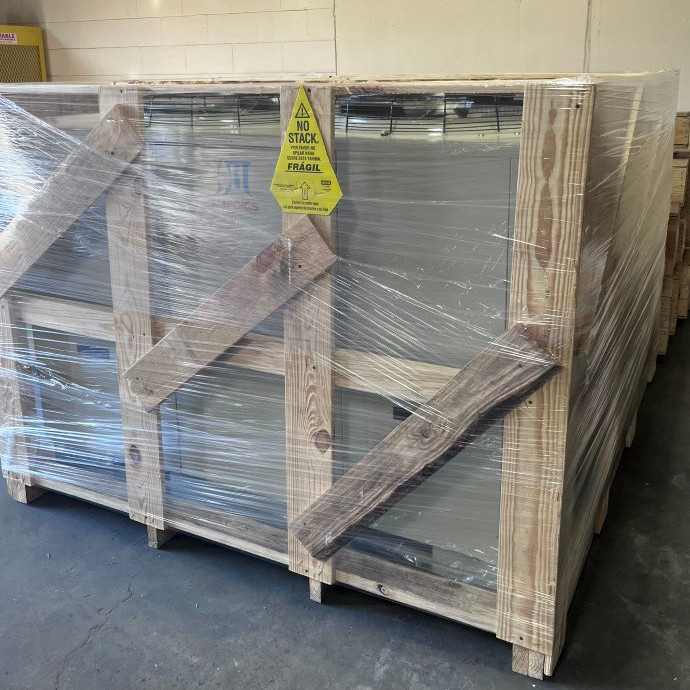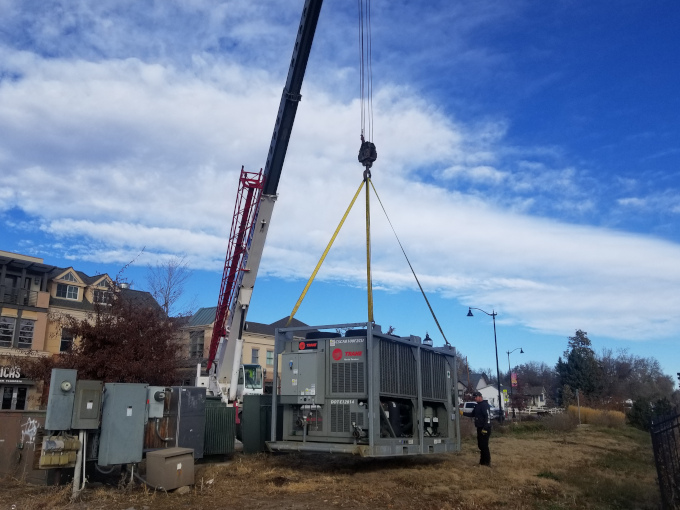Ice rink chillers come in a variety of configurations and sizes, cooling anything from your local rec center to your backyard ice rink. A chiller is a critical component of your ice rink refrigeration system, and it’s important to choose the right size unit to provide adequate cooling in all possible conditions.
Regardless of the size or cooling capacity, chillers all work in a similar way. It’s easiest to explain the process backwards, from the pipes under the ice, to the chiller itself.
The chiller pumps a cold heat transfer fluid, also known as the secondary refrigerant, through pipes under the surface of the rink. This fluid is commonly a glycol/water mixture that leaves the chiller between 10 and 15 degrees Fahrenheit. The secondary refrigerant absorbs heat from the surface of the rink and returns to the chiller at a higher temperature.
Inside the chiller, this absorbed heat is transferred to a second loop known as the primary refrigerant. The primary refrigerant circulates within the chiller and releases the heat to the environment using forced air or water cooling.
By moving heat from the rink to the chiller and then into the environment, the system keeps the rink cool and the ice frozen.
Types of Ice Rink Chillers
The type of chiller used in your rink design will vary based on the cooling load, the length of your skating season, whether your rink is indoors or outdoors, and the conditions of your local climate.
Air-Cooled Ice Rink Chillers
Air-cooled chillers are installed permanently on roof-tops or anchored to concrete. They can also be made portable for seasonal rinks. They are delivered on a trailer and can either remain trailer-mounted or set in place by a crane.
These are the most common rink chillers and are used in a variety of scenarios including seasonal rinks, temporary set-ups, indoor ice rinks and arenas. They are installed outdoors, and use forced air to reject heat from the system. They are generally lower maintenance than a water-cooled chiller, and they perform well in climates with moderate ambient temperatures.
Water-Cooled Ice Rink Chillers
Another common design, water-cooled chillers are used in areas with high ambient temperatures. They are typically installed inside the rink building and they reject heat to an outdoor cooling tower. Water-cooled chillers are generally more efficient, but they require more maintenance.

Heat Pumps & Thermal Storage
For green or “net-zero” rinks and energy savings, some ice arenas use a geothermal cooling system. Geothermal rinks use heat pumps to reject heat into a water condenser loop in the ground or a nearby body of water. They can also reroute the heat to other building systems like frost-heave protection.
This type of rink refrigeration system uses thermal storage buffers to store heat or chilled glycol for later use, allowing equipment to operate efficiently and take advantage of off-peak hours for lower cost energy usage. While not the most popular, these systems are becoming more common in commercial applications.
Residential Vs. Commercial
Ice Rink Chillers
As mentioned, from the smallest to the largest chiller, the operation is identical. What separates a residential unit from a commercial one is mainly the voltage at which they operate.

Ready for Delivery
Backyard Ice Rink Chiller
Backyard ice rink chillers operate at 230V single-phase and are available up to 20 tons of nominal cooling capacity per single packaged unit. This is the voltage commonly available at private residences and light commercial buildings.
Residential chillers work well for moderately sized backyard rinks (20×45, 30×50), but generally require a lot of amperage to run and you may be limited by the amount of power coming to your home.
Single-phase backyard ice rink chillers require 100A for a 10 ton and 150A for a 20 ton packaged unit. You can run multiple residential chillers for larger rink sizes or for year-round indoor rinks, but you may need to run a second service to achieve this.
Depending on how close your property is to a three-phase line, and the policies of your local energy provider, you may be able to upgrade to three-phase power to run a large commercial chiller, although the energy company usually installs the upgrade and the cost of doing so can be prohibitive. Rocky Rinks can help you determine the best path to a home ice rink chiller.
Commercial Outdoor Ice Rink Chiller
Commercial chillers run on a variety of three-phase voltages, most commonly 460V. This is the voltage usually available at municipal sites, industrial buildings, and some agricultural sites.
For an outdoor rink serving the public, you’ll usually want plenty of room for skaters to deliver the best experience. As a result, your outdoor ice rink chiller will likely be at least 100 tons or more to maintain optimal conditions on a large surface.
Outdoor ice rink chillers can be set up temporarily or installed permanently based on your site specifications and the needs of your event. Even if you roll up the rest of the rink refrigeration system when the season ends, having the chiller installed permanently can eliminate some storage and transportation costs.
Ice Arena Chiller
The right chiller for your training facility or ice arena will depend on the size of your rink and the local climate. For studio rinks or smaller training facilities you can get away with running multiple single-phase chillers. For most commercial indoor applications, like single or twin sheet regulation rinks, you will require a three-phase ice arena chiller.
As mentioned above, the rink design may include an air-cooled chiller, water-cooled chiller with cooling tower, or a geothermal heat pump to cool your arena. In addition to a chiller and piping, your rink will require additional mechanical systems to deliver professional ice and protect the structure of the rink building.
We highly recommend reading our page on “Ice Arena Refrigeration” for a detailed look at major components relating to the construction of a recreational ice rink or training facility.
Sizing Your Ice Rink Chiller
When calculating the required cooling capacity of the chiller for a given project, it is important to remember nominal tonnage vs tons at ice making temperature. Chillers are rated based on nominal conditions for ambient temp, leaving water temperature, and delta T. These conditions are far from ice rink design conditions, which require a chiller to deliver glycol way below freezing to effectively build and maintain the ice in your rink.
Rocky Rinks provides custom ice rinks with a conservative estimate for the true tonnage of your chiller at ice making temperatures. This estimate is based on climatic conditions of the rink site for outdoor ice rinks, as well as the building structure and envelope for indoor rinks, ensuring you get perfect ice in all conditions.
If you’re investing in a rink chiller, you’ll want to make sure your chiller can build ice fast and handle unexpected weather with ease. A well-designed rink refrigeration system will operate more efficiently and guarantee a continuous skating season without melting, refilling, and slush. For indoor surfaces, an energy efficient chiller system delivers ideal conditions for skaters and protects the bottom line.
Theoretical Cooling Capacity
of 100 Ton Chiller
| Leaving Water Temp (°F) | Propylene Glycol | 40°F Ambient | 50°F Ambient | 60°F Ambient |
|---|---|---|---|---|
| 15°F | 40% | 70.5T | 63.6T | 57.6T |
| 10°F | 40% | 57.8T | 52.2T | 47.2T |
| 5°F | 40% | 44.5T | 40.1T | 36.2T |

Our Chiller Services
- Refrigeration System Design
- Chiller Sales
- Chiller Installations
- Chiller Upgrades & Replacements
Need help choosing the right chiller for your rink? Get started on a rink design below
